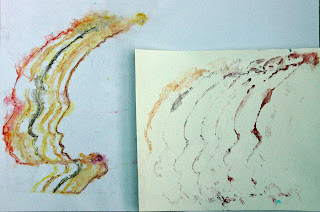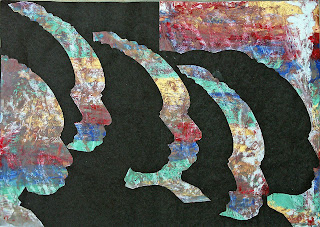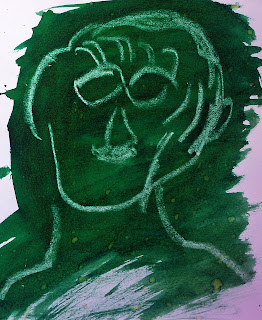
Image 2 (size 24 inches by 16 inches)
This is a painted design of a variety of shapes of leaves, faded flowers and seed heads on paper. The design moves in an arched shape across the paper and is the actual size I will probably work to.  IMAGE 3 (Size 24 inches by 16 inches)
IMAGE 3 (Size 24 inches by 16 inches)
 IMAGE 3 (Size 24 inches by 16 inches)
IMAGE 3 (Size 24 inches by 16 inches)Having drawn the design on paper I began to experiment with potential backgrounds and materials for leaves. At the top of this image is a strip of buckram . The left hand side is its natural shade whilst the right hand side is coloured with fabric paint. The leaves are painted on with acrylics.
The bottom strip is formed by painting bondaweb and fusing it to both sides of a strip of abaca fibre. This gives the paper like quality of leaves in Autumn.
I then went on to experiment with making the leaves metallic. In this image at the Top left the green leaves surrounding a previously worked sample for this module were made from fragments of metallics and organza on a base of acrylic felt . The design was drawn on the back of the felt and stiched from the back. the excess felt and front fabrics were then bunt away and some of the layers were melted through to reveal the metallics. In the centre (between the green leaves and the embroidery hoop) is a leaf cut from the bondaweb /abaca sandwich and then dusted with copper embossing powder. The leaf could then be further defined by stitching in metallic threads. In the embroidery hoop there are a number of leaf shapes cut from a bonded sandwich of organza and metallic fragments. In addition one of the leaves has had copper wire applied to its main veins. The reason for this was twofold-- firstly to add definition and secondly to enable the finished leaf to be bent into shape . On the bottom row leaf shapes have been cut from gold mesh, metallic plastic film and copper shim. At present these are in ' raw' state prior to further decoration.
 From these initial experiments I believe I could make a sample on the painted buckram with a gold wire 'bough' in an arched shape and fixed about two inches above and across the design. it would then be possible to work leaves both flat on the painted background and then additional
metallic leaves could be made, using a variety of techiniques, and fixed to the bough.
From these initial experiments I believe I could make a sample on the painted buckram with a gold wire 'bough' in an arched shape and fixed about two inches above and across the design. it would then be possible to work leaves both flat on the painted background and then additional
metallic leaves could be made, using a variety of techiniques, and fixed to the bough.
 From these initial experiments I believe I could make a sample on the painted buckram with a gold wire 'bough' in an arched shape and fixed about two inches above and across the design. it would then be possible to work leaves both flat on the painted background and then additional
metallic leaves could be made, using a variety of techiniques, and fixed to the bough.
From these initial experiments I believe I could make a sample on the painted buckram with a gold wire 'bough' in an arched shape and fixed about two inches above and across the design. it would then be possible to work leaves both flat on the painted background and then additional
metallic leaves could be made, using a variety of techiniques, and fixed to the bough.Happy to discuss further before starting on a first mock up.
CHAPTER 15 STUDY OF TWO CONTEMPORARY TEXTILE ARTISTS.

















( sample size 8inches square)
From left to right --Copper shim with metallic pint and ageing fluid ; brass Schlag .
top right copper schlag, aluminium drink can ( all treated with the same chemicals)
Small square of brass soaked in vinegar for 5 weeks.
The Cambridge Library of Medieval Ornament
The Grammar of Ornament Owen Jones.
Time taken.
Chapter 14 Designing/painting 5hours, leaf samples 5 hours, painted bondaweb sample 2 hours
Chapter 15 Researching textile artists 12 hours
Patination of metals 30 minutes
Photography and editing 2 hours
Blog set up and typing 3 hours.
Materials
Abaca fibre £1.75
Chemicals for patination £ 10 ( a ten year supply !!!!)































